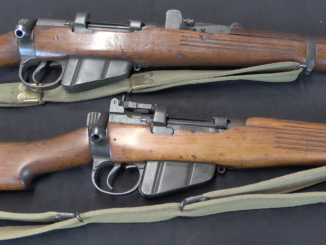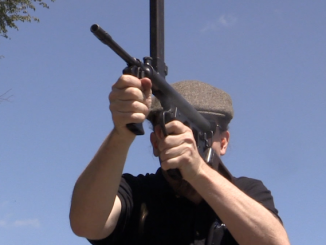When World War Two began, Australia saw little threat of invasion from Germany (obviously), and sent a substantial number of firearms to Britain to help arm the Home Guard there, which was seriously concerned about the possibility of a German invasion. When Japan and Australia declared war in December 1941, the situation immediately became much more serious for Australia, and the government began looking for arms.
At the start of the war, there were effectively no submachine guns at all on the continent – just a couple examples. These included an MP38 somehow confiscated by Australian customs, which would take on a significant role. Australia looked to Britain for arms, and they were sent a technical data package to produce the Sten MkII – but found the design pretty underwhelming. Australian manufacturers decided to make their own improvements to it, using elements of the MP38 – specifically the sealed telescoping recoil spring system and underflowing stock. They also gave the gun a pair of pistol grips for improved handling.
The Owen SMG was going into production at this time, and had been in development for a while under private civilian supervision. The Australian Sten, called the Austen, lacked that developmental track record and it went into production without passing proper trials. It faced significant manufacturing delays and reliability problems, and was not well liked by troops – in contrast to the excellent Owen. The Austen was ultimately made in smaller numbers than the Owen (19,914 of the MkI guns) and pulled from combat use in August of 1944.
Many thanks to the Royal Armouries for allowing me to film this very rare artifact! The NFC collection there – perhaps the best military small arms collection in Western Europe – is available by appointment to researchers. However, you can browse the various Armouries collections online.




What we have here is a failure to idiot-proof an already idiocy-prone design! The hand grip is better than grabbing the magazine or the barrel collar, but lack of field testing means disaster. I think the quartermaster hid under his bed when complaining soldiers came knocking.
The Austen looks like a well made gun. What was actually wrong with it in the field. If it was unreliable, why was this?
35+ years ago, I saw a WWII era reference work on firearms which included a glowing report on the Austen. They seemed inordinately impressed with the telescoping spring-cover. I don’t remember if the same book included a piece on the Owen. But it also included a review of the Reising that found every possible virtue in THAT design.
Sadly, I don’t recall the title, and the book was long ago weeded out of the Oakland Public Library.
The major problem with the Austen wasn’t lack of reliability. It was more reliable than the Sten MK II, and did not have the “bounce-bang” problem of the MP38.
The drawback of the Austen was simply that it was expensive to make. It require fairly complex machining, and fine tolerances, all of which caused problems with time and costs in wartime production.
It also required the same sort of complex stripping procedure for field maintenance as the MP38, which was one of the drawbacks of the Erma design in Wehrmacht service.
The Owen was a less elegant design, but it was faster and cheaper to make, was extremely rugged and reliable, simple to maintain in the field, and when all was said and done it was an efficient short-range man-killer. Which is really all a sub-machine gun needs to be.
If more than that is required, you probably should have been using a rifle to begin with.
cheers
eon
Interestingly Polish resistance also produced STEN-Erma hybrid in 1940s, named BŁYSKAWICA
https://modernfirearms.net/en/submachine-guns/poland-submachine-guns/blyskawica-eng/
shortly speaking:
– basically STEN, though no fire mode selector (fire exclusively full-auto)
– layout Erma (magazine sticking downward, folding stocking, pistol grip)
– made in conspiracy, so maximally simplified
Article about Blyskawica was featured here a long time ago (6,7 years or more), I doubt any gun researcher has never heard of it by now.
Anyways I do not see how it is with anything connected to Austen and why a need to brought it up.
Both:
– were developed from STEN and inspired by MP38 or MP40
– created where there were almost no prior experience in designing sub-machine guns
– in times when sub-machine guns (or any fire-arms) were badly needed
Difference is that BŁYSKAWICA production was in conspiracy, which lead to greatly differences in manufacturing between it and AUSTEN.
In some articles, Owen is described and branded as being actually gen 1. submachine gun, fairly expensive to make as was Thompson or Bergmann, that people by mistake of weird looks put in the same bag as Sten…
My last comment is regarding Eon and “Owen simpler to make than Sten” statement.
“The Owen was a less elegant design, but it was faster and cheaper to make, was extremely rugged and reliable, simple to maintain in the field, and when all was said and done it was an efficient short-range man-killer.”
Also I suspect AUSTEN magazine as being single-exit type (like STEN) would be harder to load to nominal capacity (takes more time) than OWEN using only fingers. There exist magazine filler tool for STEN, was similar device issued with AUSTEN?
Forward grip and magazine sticking to side? Rather uncommon in sub-machine gun design, but not single in history, c.f. SIG model 1930, see 1st photo from top: https://modernfirearms.net/en/submachine-guns/switzerland-submachine-guns/sig-1920-1930-eng/
I’m kind of mad that I thought it was the “Austen” because it was named after someone…like the Owen…not. AU-STEN.
Keep calm, there are moments of enlightenment, for me it was founding that:
British A22 tank was not named after W.S.Churchill (First Lord of Admiralty during Great War) but Sir John Churchill, 1st Duke of Marlborough at least according to the first one:
The A22, Tank, Infantry Mk.IV (the Mk.III was the Valentine) might seem like it was named after the iconic British leader of the time. But -according to Churchill himself- the name honored the memory of his XVIIth century ancestor, Sir John Churchill, 1st Duke of Marlborough.(…)
http://www.tanks-encyclopedia.com/ww2/gb/A22_Churchill_Tank.php
Australian Sten. Sten being Spencer & Turpin, designers, plus Enfield, manufacturer. The Owen could have been the Auswen.
We see what you did there …lol
Not Enfield. The EN in STEN stands for England.
Yep, Im also leaning towards that, but there is a heated discussion about it; Turpin said it stands for England.
According to Wayne Wardman’s book, in 1944 an Owen Gun cost 14.50 Australian Pounds, the Austen cost 12.00 or 16.30 Australian Pounds depending upon the manufacturer. Similar ratios of man-hours also applied to the manufacture of the two guns ie fairly insignificant difference in cost. One disadvantage of the Austen I believe was the excessive length of the folding stock, which made for poor handling.
In Australian military historical accounts, one rarely finds any mention of the Austen. There are plenty of Austens to be seen in Australian museums.
The Austen had a screwdriver to remove the grips at the front to access its spares kit.
In the 70’s or early 80’s some Austen assembly’s were sold through Army disposal shops. I bought a front grip/magazine well assembly and found an oiled bag full of all the spare small springs, pins etc inside.The casting I have is either zinc or aluminum rather than the bronze or brass one in the video.
Incidentally the Diecasters ltd factory building in Richmond Victoria (an inner suburb of Melbourne) is still standing, but has been converted into upmarket offices. 128 Cromwell st Richmond Victoria if anyone want to see it on google maps.
There were two manufacturers of the Austen one in Sydney and one in Melbourne to ensure redundancy in case of bombing, the Owen was made by Lysarts at Port Kembla and Newcastle. Submachine gun production was spread over four different locations not a bad idea, if only the Austen had been better.
I think Ian probably unintentionally badmouthed this gun, and that based not on its poor performance (original Sten is also so-so), but of manufacturing and design modifications, which were in my opinion, good addition.
Australia was never in frenzy situation as UK, and pushing for making a maximum number of fairly crappy guns is not always the best option, Brits made many Stens, yet lot of them were unissued and got scrapped immediately after the war – aussies at least kept theirs in storage up until 60s.
Also, brits had scattered the Sten production to the point of being ludicrous and questionably cheaper – there are archive pics of “workers” turning bolts “in some chicken shed” just to be shipped via lorry to the next village where they performed milling operations (!). Why not do it all in the same place?? (after that it went to the third place for hardening!). It opens a discussion was production of such items really a rational wartime necessity, or it has a great deal of “victory employment for everyone” trickery in it, not to mention it even slightly reminds of failed economy communist mindset in producing just for meeting quotas (fat books with lot of pages, then lot of thin books with few pages,etc.)
I’ve commented that before, it would be interesting to see battle records of Sten compared to PPSh and MP40, yeah lot of soldiers carried it, but how many succeeded in “neutralising” an enemy with it?
Sure you could opt for even maximum simplistic MP 3008 approach, but why – if you for example have only 3 soldiers, but could make 5 crappy smgs that its users would struggle to love.
Why not invest in making a slightly improved and better product and make your end user a little bit more satisfied.